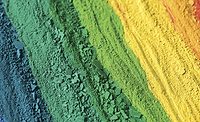A Pigments Market Overview
Outlook, Trends, and Challenges

courtesy of LANXESS

Renata Rodrigues, Head of LANXESS Inorganic Pigments Americas


As we reach the mid-point of 2024, there are a lot of questions surrounding market strength, trends, and challenges in the coatings industry. PCI recently interviewed Renata Rodrigues, Head of LANXESS Inorganic Pigments Americas, to get her input on the current state of the pigments segment of our industry.
PCI: How do you assess the market for pigments for the coatings industry?
Rodrigues: Due to the weakness of the construction industry and consumer restraint in the DIY sector, global demand for synthetic iron-oxide pigments used for coatings applications fell by around 10% in 2023, and then stabilized at this level. Now that manufacturers have reduced their inventories, we are seeing a slight recovery in 2024, particularly in North America. In addition, customers are increasing their inventories at short notice due to current uncertainties in global supply chains. We, therefore, recommend taking this rising demand into account in inventory planning.
PCI: What trends do you see in the market right now?
Rodrigues: We see that a large number of our customers are actively working on strategies to reduce emissions along the entire supply chain. The demand for detailed life-cycle-assessment data for raw materials is growing, and this includes pigment suppliers and their products. There is a demand for certified evidence, especially for the product carbon footprint (PCF) of pigments. LANXESS is focusing on transparency here and is able to provide reliable information on the PCF in the form of verified environmental product declarations. In addition, we are working on specific projects to continuously reduce the carbon footprint of our products and introduce new "green product lines.”
PCI: What challenges do you see for pigment manufacturers/pigment suppliers?
Rodrigues: Geo-political tensions remain a fundamental risk for the supply chains of iron-oxide pigments from production sites in Asia. In addition, there are currently disruptions in container shipping on routes via the Red Sea and the Panama Canal, which are leading to delays in deliveries both to and from Asia. Suppliers such as LANXESS, who have a global production network with regional sales structures, offer paint and coatings manufacturers the advantage of being able to minimize the effects of regional dependencies in the supply chain. However, it should be noted that the provision of such a production setup is also associated with a different cost structure for the supplier, in which regional factors such as higher energy costs in Europe, must be taken into account.
PCI: How is the ongoing consolidation affecting the pigment market?
Rodrigues: Consolidation in the manufacture and supply of iron-oxide pigments is well advanced following the latest acquisitions. Today, around 60% of all synthetically produced iron-oxide pigments come from China. LANXESS is still a "Western player" with a global production network and significant capacities for the paints and coatings industry. Around 70% of the production volume manufactured outside China comes from LANXESS production sites.
*All images courtesy of LANXESS.
Looking for a reprint of this article?
From high-res PDFs to custom plaques, order your copy today!








